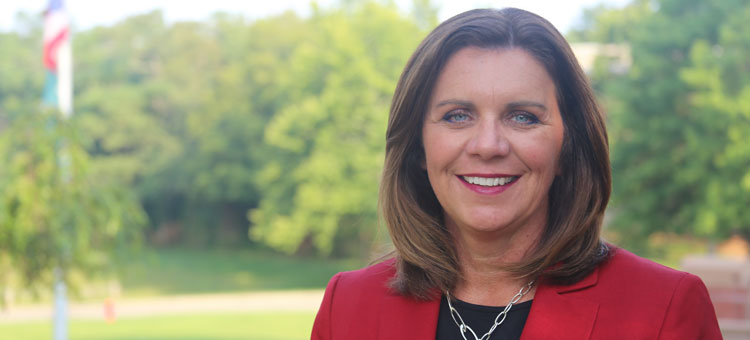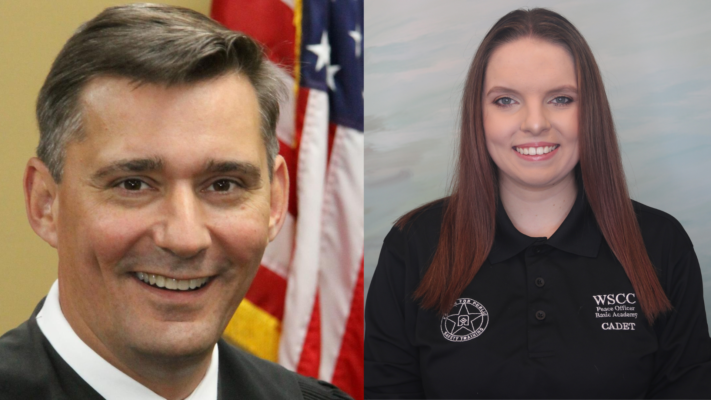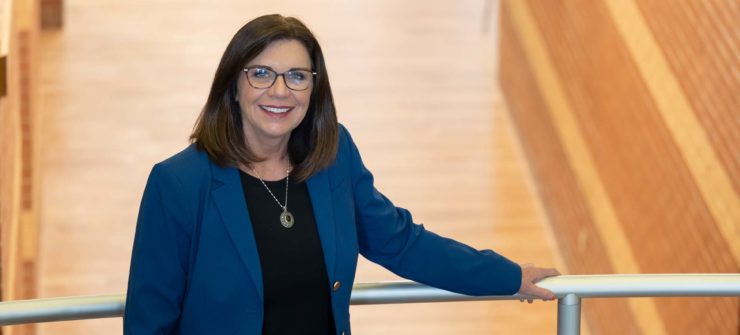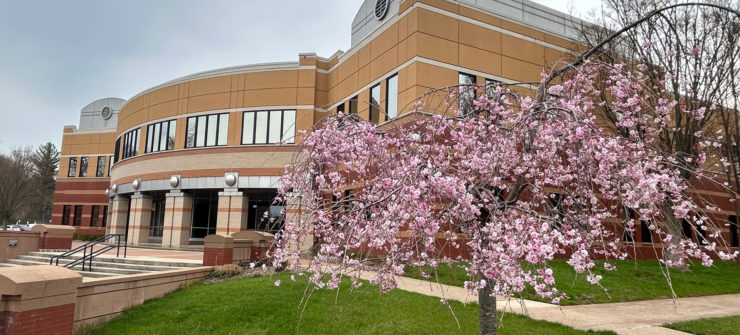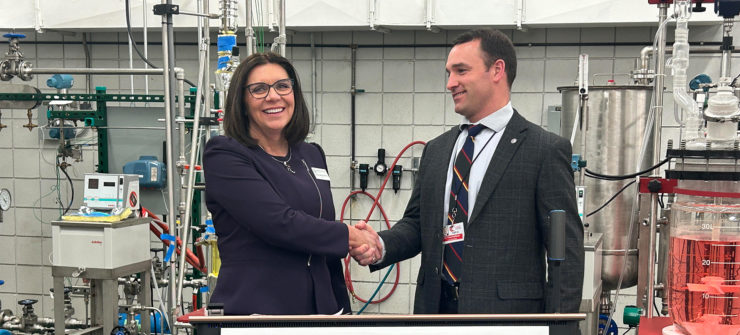Washington State College of Ohio’s President Dr. Vicky Wood and Workforce Development Director Gary Barber are testifying before the Ohio Senate Workforce and Higher Education Committee seeking support of Senate Bill 135.
Senate Bill 135 will provide community colleges the opportunity to address the statewide nursing shortage, by expanding their degree-granting authority to allow them to offer bachelor’s degree programs. Currently, the Chancellor of Higher Education is only permitted to authorize applied bachelor’s degrees at community colleges, and the bachelor’s degree in nursing (BSN) is not an applied bachelor’s degree. Under the bill, the arbitrary term “applied” is removed and community colleges throughout the state are given the ability to offer a BSN.
Chairman Johnson, Vice Chairman Cirino, Ranking Member Williams, and members of the Senate Workforce and Higher Education Committee, my name is Dr. Vicky Wood and I am the president of Washington State College of Ohio (WSCO) located in Marietta. I come before you today imploring your support of Senate Bill 135. This legislation will give community colleges the opportunity to answer the calls of our local employers and finally allow us to address the statewide nursing shortage, which is reaching near crisis levels in rural areas.
The nursing shortage has impacted our employers and economy for decades. The demand was further intensified when in 2010 the Institute of Medicine released a report that called for increasing the number of baccalaureate-prepared nurses in the workforce to 80% by 2020. Despite the heightened push across the nation, the benchmark fell short. In fact, only 57% of Ohio nurses have a baccalaureate or higher level of nursing education.
For as long as anyone in Southeast Ohio can remember, there has existed a shortage within our region. As we stand here today, the two largest hospitals in the area (Memorial Health System and Camden Clark Medical Center) currently have more than 120 job postings for nurses that require them to hold a bachelor’s degree. While that shortage is alarming enough, both hospitals project that the number of openings will only continue to grow as a new wave of retirements is expected as we emerge from the COVID-19 pandemic.
The southeast region of Ohio in particular is feeling the impact of insufficient baccalaureate nurses. For instance, the nursing shortage has cost Memorial Health System millions of dollars over the last four decades. In January of this year alone, they spent $3.1 million in traveling and International nurses to fill their nursing gap. This isn’t only an egregious use of their budget, it increases the state of Ohio’s Medicaid spending, and it’s detrimental to our local economy because it removes the local workforce from the equation.
While they rely on Washington State as a primary resource for their nurses, as a community college, we are only able to fill their Associate Degree Nursing (ADN) needs. In fact, of their more than 425 ADNs, the majority are our alumni. For many years they have conveyed their desperate need for additional BSNs and have worked with us to facilitate partnerships. While we have made several attempts, what we keep hearing from prospective students is that they are looking for options that are local, flexible, and affordable. Currently, such an option simply does not exist in our area.
In the past decade, Washington State College of Ohio has graduated 282 Associate Degree Nurses, yet only approximately 17% have opted to pursue a bachelor’s degree because of the limited opportunities in southeast Ohio. This disproportionally affects adult graduates. They do not pursue a BSN because they have family, children, and work responsibilities that keep them in this region. To reach these students, higher education has to become more flexible and diverse in its offerings, instead of asking the student to become more flexible. The latter strategy simply has not proven to work with most adult students.
From an equity perspective, our data indicates that the traditional option to transfer to a university tends to be most attractive to the traditional-aged college student. However, to the detriment of our local economy, once they leave, they often never return. Instead, they increasingly choose to seek employment where they had their clinical experience. Our adult learners, a demographic whom we have found to have family obligations and strong ties to the community, are only left with the online option. While this seemingly is an acceptable alternative, we repeatedly find that our local hospitals’ employees are resistant to pursue this pathway, citing preference for a local, in-person option.
Current Ohio law is part of the problem. Despite the fact that the state has invested public resources into Washington State’s nursing program by helping us build our facilities, purchase our equipment, and hire qualified faculty, the Chancellor of Higher Education is only permitted to authorize applied bachelor’s degrees at community colleges, and the bachelor’s degree in nursing is not an applied bachelor’s degree. This is an inefficient use of state resources, which keeps those institutions best suited to help address this workforce shortage sitting on the sideline.
Senate Bill 135, sponsored by Senator Cirino, offers a long-awaited solution. Under the bill, the arbitrary term “applied” is removed and community colleges throughout the state are given a clear path forward on how we can finally help our local employers. The truth is that we need every existing nursing program in the state in the game in order to meet the challenge of Ohio’s critical nursing shortage. The existing programs at universities need to do better, and the programs at community colleges need to be allowed to expand. Finally, we believe that employers need to be in the driver’s seat on these decisions. If employers are willing to both support a college’s efforts to offer the BSN and demonstrate their willingness to hire our graduates, then many of the arguments of those who are in opposition to Senate Bill 135 will be proven to be without merit. Luckily, current law does allow for employers to have the ultimate say on these issues, and Senate Bill 135 actually strengthens the role they will play as the ultimate arbiter of any suggestion that opponents of Senate Bill 135 may raise.
With your support of SB 135, WSCO is poised to meet the needs of our local hospitals. We have collaborative models already in place that can be replicated in innovative ways to move students from LPN to ADN to BSN. We have established a plan that, after just one semester at Washington State, students will be able to transition into the workforce. This step will result in a trifecta: our hospital will save millions and have the workforce they need, our students will earn a living wage while advancing their education and earning potential, and ultimately our overall local economy will be strengthened.
Chairman Johnson, Vice Chairman Cirino, Ranking Member Williams and members of the Senate Workforce & Higher Education Committee, my name is Gary Barber and I am the Director of Workforce Development at Washington State College of Ohio (WSCO) located in Marietta. I come before you today enlisting your support of Senate Bill 135, and to amplify the concerns of local employers. I work with them daily in my role at the college, and can confirm that this legislation is desperately needed by our workforce partners, including our region’s largest employer, Memorial Health System. Two members of this committee have directly served in the healthcare industry and are aware that in order to address the critical shortage of health care workers, policies need to be modified. Prior to the pandemic, the healthcare industry had just one-quarter of the workers needed to care for the aging Baby-Boomer population. The workforce was further strained by the pandemic. Many nurses who were close to retirement or immunocompromised decided to retire and left the industry. In a recent conversation with Memorial Health System, CEO Scott Cantley explained why the need for BSN’s continues to rise, even with a declining population in Appalachia. Cantley explained that Southeast Ohio has one of the most elderly populations in the entire nation, as confirmed by US census data. This is compounded by a 26.6% poverty rate, compared to the 13.1% state average, which will accelerate our need for healthcare workers over the next two decades. The largest portion of expense in educating a nurse comes in the first two years required for the associate degree. For this reason, community colleges can easily expand their curriculum to offer the second two years required for the BSN to fulfill the BSN workforce need in our region. A majority of the courses needed for the BSN are actually already offered at WSCO, and we can provide the second half of a student’s educational journey with limited institutional costs. Ohio community colleges have strong relationships and already established partnerships with their healthcare partners. We have both the infrastructure established to support this venture and the desire for our workforce to produce more BSN’s in the immediate future.
As a rural community in Southeast Ohio, our employers are faced with an additional challenge as our healthcare systems try to recruit BSN graduates back from four-year universities that are more than sixty miles away from our region. Students who leave our region to attend BSN programs in Athens and Columbus complete their clinicals and are highly recruited in those regions. This is understandable because of the desperate need for BSNs across the entire state. Our local healthcare systems would far prefer the opportunity to recruit BSN’s who attend classes locally, and are deeply rooted in our region. Many of our local employers are willing to pay for the costs for one of their nurses to pursue a BSN. However, hospitals in our area feel pressure from numerous fronts to keep their costs low. The average cost to complete a BSN at the nearest four-year institution is $40,000. At Washington State College of Ohio, that cost would be reduced by more than half. In addition, we have worked with employers on a pathway where new students would be prepared to enter the workforce after the first semester of nursing. This will reduce student debt, provide students with an income while completing their BSNs, and fuel the local healthcare workforce and economy.
At Washington State College of Ohio, we believe that with the continued tremendous support of our healthcare industry partners, we can help support the nursing workforce gap. By listening to the needs of our employers, and Washington State’s willingness to be creative in the design of our programs, we are prepared to implement brand new strategies into our area, such as second degree accelerated BSN programs and three-year BSN programs, if permitted to do so through SB 135. We believe this demonstrates to our employers our willingness to think differently and urgently, in order to provide them with new graduates as quickly as we can. Dr. Wood humbly described Washington State College of Ohio’s Associate Degree Program. In fact, our Associate Degree Nursing program (ADN) was ranked as the number one ADN program in Ohio according to RNCareers.org. Moreover, WSCO ranked 44th out of 1,046 schools from across the nation in the RN Careers’ annual report. The program’s current NCLEX-RN pass rate is 96.96%, which is more than 10% higher than the national average and over 12% above the state average. Based on our programs’ phenomenal outcomes, it is evident that we know how to do this work and if finally given the chance, we know we will be able to deliver what our employers are asking us for.
Thank you, Chairman Johnson and members of the committee for the opportunity to testify today and represent the long-standing view of our employers who desperately want Washington State College of Ohio to have the ability to train BSN Nurses for them. I would be happy to answer any questions that you may have.
Chairman Johnson, Vice Chairman Cirino, Ranking Member Williams and members of the Senate Workforce & Higher Education Committee: My name is Scott Cantley and I am the President and CEO of Memorial Health System, a three-hospital system with current operations in Washington County, Ohio; Tyler County, West Virginia; and surrounding counties. We are the region's largest employer with approximately 3,300 employees.
I am sorry I cannot be with you today in person, but I wanted to ensure you hear our story. There will be much said about workforce shortages and statistical projections of anticipated future needs throughout the testimony today. Unfortunately, statistics won't tell you about the real conditions on the ground here in Marietta, OH, Our mission as an organization is to bring truly world class health care to our rural, southeast region. That is a challenging endeavor for all the economic reasons I'm sure you and members of your committee fully understand.
Healthcare as an industry is often represented by large complex buildings with sophisticated medical equipment inside. We use very exciting industry jargon to name our technology - cat scanners, cath labs and even Da Vinci Surgical robots. It is interesting we often push these images to the forefront of newscasts about hospitals and healthcare when the reality is the vast majority of our investments is in people. In my April 2021 financial statements, the cost of salaries, wages and benefits is exactly 14.7 times the cost of buildings and equipment (as represented by accumulated depreciation.) For each one dollar I spend monthly on high tech tools, huge buildings and parking garages, I will spend 15 times that on my workforce. The reality of healthcare is we are truly a people industry driven by one of the most highly educated workforces in the world.
In rural Ohio, the challenge of building great healthcare is not architectural or technical. The challenge is about building the right workforce. We must hire great physicians and provide our medical team with appropriately skilled nurses, radiology techs, laboratory science technicians, respiratory therapists and on and on. These professional groups are the real building blocks of great health care. During our COVID-19 community situation, I was impressed by the response of our government to create amazing new healthcare capacity on naval ships and in convention centers. The reality was that little, if any, of this capacity and expense was used. Why? Because the shortage for most of this nation was never beds, rooms and equipment, although ventilators were helpful! What we really needed was staff to treat patients in all our facilities. During 2020, the cost to hire a “traveling nurse” (our friendly industry term for contracted nurses willing to commit to six-week employment for higher fees) tripled as each city in the United States competed to get the labor pool necessary.
In Marietta, at our peak COVID-19 crisis, 13% of my nursing workforce was "travelers." This premium adds nearly two million dollars of monthly expense to our health system. My current, non-peak staffing is 10% of the nursing workforce of nearly 600 bedside nurses. Additionally, we consistently run with an approximately 10% vacancy rate that is staffed by overtime. Typically, we offer shift bonuses to nurses in addition to their overtime rates of pay. Today, triple bonuses have been insufficient to induce nurses to voluntarily work the extra shifts we need to respond to our community's needs. Let me assure you no rural community can sustain these premium expense levels while addressing the impact of our greater safety net burden placed in rural communities. In fact, we are often penalized in our payment rates by Federal and State programs under the presumption that wage costs are lower in rural communities. In healthcare, nothing could be more false. Our cost of attracting talent, physician or other highly skilled professionals like nurses, will be higher than those of the urban communities that produce the graduates for. Amenities and job opportunities are plentiful in Columbus, Cincinnati and Cleveland and ultimately reduce the recruitment costs in their competitive labor markets for the urban hospitals and facilities in their health systems.
Committee members, I respectfully submit we are still facing a crisis in rural American healthcare. It is no longer a pandemic but is our ability to field a workforce that can meet the community needs of the Medicare and Medicaid populations still disproportionately residing in rural communities. In Washington County, our hope rests on the strength of our partnerships with regional colleges like Washington State College of Ohio. By collaborating with Dr. Vicky Wood and her team, MHS is building a pipeline of labor for our future. Nursing particularly requires special attention. As healthcare shifts to greater primary care and outpatient focused delivery modalities, those patients being admitted to hospitals have higher acuity and greater nursing needs. Our care models within the hospital are adapting accordingly. Baccalaureate and Masters prepared professional nurses are assuming a larger team role in the care of acutely ill patients. The assessment skills of professional nurses are essential to the post-surgical and complex medical care being delivered today in hospitals.
If we are to retain our community hospital infrastructure in this country, a workforce must be developed in rural communities. Previously the mix of BSN and MSN academic preparation I'm referring to was almost exclusively in academic and tertiary medical facilities. Encouraging our young nurses to leave Marietta to complete this academic preparation and then expecting them to return is, in our experience, a bad investment. Allowing young professionals to build families and careers in their hometowns will be the only way we change the paradigm I've described here today.
We respectfully ask you to value communities that want to thrive without the benefit of large universities embedded within them. You can accomplish this by enabling a carefully selected subset of community colleges to expand their partnership and impact within communities like ours. I fully support Washington State College of Ohio's request to advance the ADN program to a BSN program.
Respectfully,
Scott Cantley, President and CEO Memorial Health System
